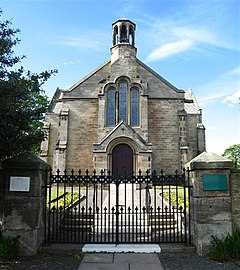
East Lothian is one of the 32 council areas of Scotland, as well as a historic county, registration county and lieutenancy area. The county was called Haddingtonshire until 1921.
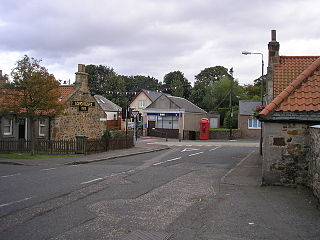
Longniddry is a coastal village in East Lothian, Scotland, with an estimated population of 2,340 in 2020. The Scottish Women's Rural Institute was founded here in 1917.

Cockenzie and Port Seton is a unified town in East Lothian, Scotland. It is on the coast of the Firth of Forth, four miles east of Musselburgh. The burgh of Cockenzie was created in 1591 by James VI of Scotland. Port Seton harbour was built by the 11th Lord Seton between 1655 and 1665.

The Royal Burgh of Haddington is a town in East Lothian, Scotland. It is the main administrative, cultural and geographical centre for East Lothian. It lies about 17 miles east of Edinburgh. The name Haddington is Anglo-Saxon, dating from the sixth or seventh century AD when the area was incorporated into the kingdom of Bernicia. The town, like the rest of the Lothian region, was ceded by King Edgar of England and became part of Scotland in the tenth century. Haddington received Burgh status, one of the earliest to do so, during the reign of David I (1124–1153), giving it trading rights which encouraged its growth into a market town.

Tranent is a town in East Lothian, in the south-east of Scotland. The town lies 6 miles from the boundary of Edinburgh, and 9.1 miles from the city centre. It lies beside the A1 road, the A1 runs through the parish splitting the parish from its associated villages and hamlets namely Meadowmill and the port of the parish Cockenzie. The original main post road ran straight through the town until the new A1 was built. Built on a gentle slope, about 90 metres (300 ft) above sea level it is one of the oldest towns in East Lothian. The population of the town is approximately 12,140, an increase of over 4,000 since 2001. Tranent was formerly a major mining town, but now serves as a commuter town for Edinburgh.
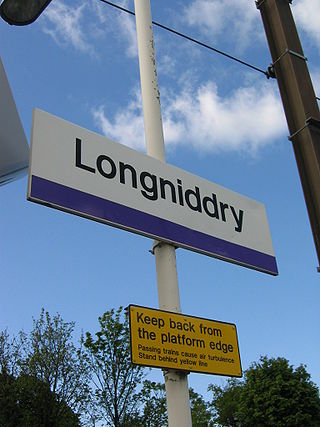
Longniddry railway station is located at the southeast corner of the coastal village of Longniddry, East Lothian, Scotland. The station is on the East Coast Main Line, 13+1⁄4 miles (21.3 km) east of Edinburgh Waverley, and is served by stopping passenger trains on the North Berwick Line.

Macmerry is a village located on the old A1 just east of Tranent.

Prestonpans is a small mining town, situated approximately eight miles east of Edinburgh, Scotland, in the council area of East Lothian. The population as of 2020 is 10,460. It is near the site of the 1745 Battle of Prestonpans. Prestonpans is "Scotland's Mural Town", with many murals depicting local history.
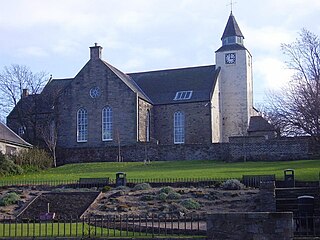
Prestongrange Parish Church is a Church of Scotland kirk situated in the small, former mining town of Prestonpans in East Lothian. The church was built in 1596, one of the first churches to be built in Scotland following the Scottish Reformation in 1560. In 1606, Prestonpans was created a parish in its own right following centuries of being part of the parish of Tranent.
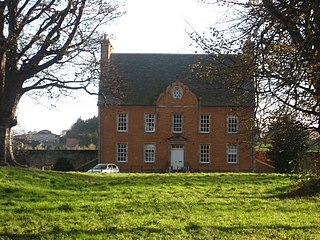
Bankton House is a late 17th-century house situated south of Prestonpans in East Lothian, Scotland. The house is located between the A1 road and the East Coast Main Line railway at grid reference NT394736.
The Macmerry Branch was a North British Railway built double track branch railway line in East Lothian, Scotland, that ran from a junction west of Inveresk on the East Coast Main Line to Macmerry via four intermediate stations, Smeaton, Crossgatehall Halt, Ormiston, and Winton. Two lines ran off the branch line, one a spur line to Hardengreen Junction on the Waverley Line from Smeaton, and the other a branch line to Gifford from just past Ormiston.

Elections to East Lothian Council were held on 1 May 2003, the same day as the other Scottish local government elections and the Scottish Parliament general election.

Elections to East Lothian Council were held on 6 May 1999, the same day as the other Scottish local government elections and the Scottish Parliament general election.
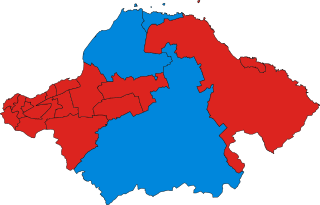
Elections to East Lothian Council were held on 6 April 1995, the same day as the other Scottish local government elections.
John Farquharson (1847–1933) was a Scottish architect operational in the late 19th century and early 20th century. He designed several schools in the East Lothian district.

Elections to the East Lothian District Council took place in May 1992, alongside elections to the councils of Scotland's various other districts.
Elections for the East Lothian Council took place in May 1988, alongside elections to the councils of Scotland's various other districts.
Elections for East Lothian District Council took place on Thursday 3 May 1984, alongside elections to the councils of Scotland's various other districts.
The 1980 East Lothian District Council election for the East Lothian Council took place in May 1980, alongside elections to the councils of Scotland's various other districts.
